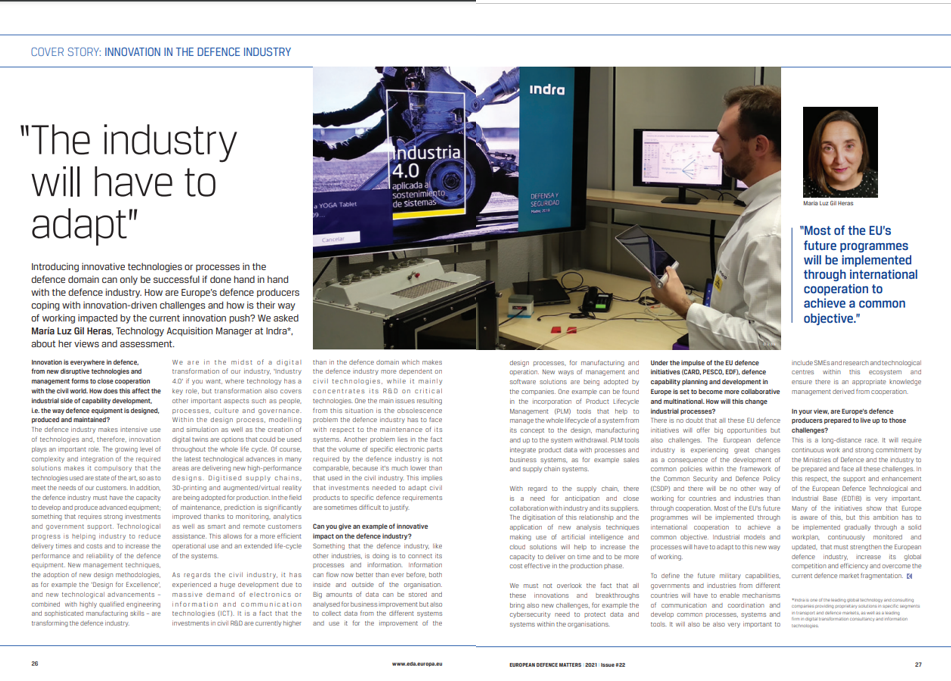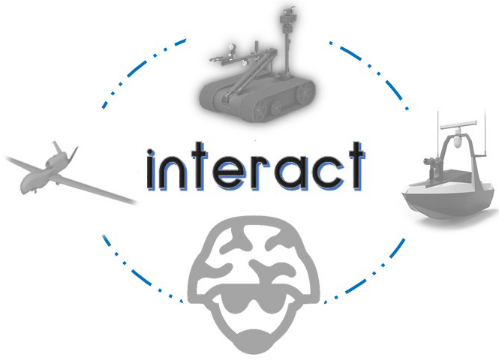INNOVATION IN THE DEFENCE INDUSTRY | European Defence Matters Magazine
INNOVATION IN THE DEFENCE INDUSTRY | European Defence Matters Magazine
A very interesting interview about the innovation in the European defence industry was given by the INTERACT PADR partner, INDRA, in the latest issue of European Defence Matters magazine (Issue No. 22) . You can read below the full interview or view it on EDA’s website (pp. 26 – 27).

“The industry will have to adapt”
Introducing innovative technologies or processes in the defence domain can only be successful if done hand in hand with the defence industry. How are Europe’s defence producers coping with innovation-driven challenges and how is their way of working impacted by the current innovation push? We asked María Luz Gil Heras, Technology Acquisition Manager at Indra*, about her views and assessment.
Innovation is everywhere in defence, from new disruptive technologies and management forms to close cooperation with the civil world. How does this affect the industrial side of capability development, i.e. the way defence equipment is designed, produced and maintained?
The defence industry makes intensive use of technologies and, therefore, innovation plays an important role. The growing level of complexity and integration of the required solutions makes it compulsory that the technologies used are state of the art, so as to meet the needs of our customers. In addition, the defence industry must have the capacity to develop and produce advanced equipment; something that requires strong investments and government support. Technological progress is helping industry to reduce delivery times and costs and to increase the performance and reliability of the defence equipment. New management techniques, the adoption of new design methodologies, as for example the ‘Design for Excellence’, and new technological advancements – combined with highly qualified engineering and sophisticated manufacturing skills – are transforming the defence industry.
We are in the midst of a digital transformation of our industry, ‘Industry 4.0’ if you want, where technology has a key role, but transformation also covers other important aspects such as people, processes, culture and governance. Within the design process, modelling and simulation as well as the creation of digital twins are options that could be used throughout the whole life cycle. Of course, the latest technological advances in many areas are delivering new high-performance designs. Digitised supply chains, 3D-printing and augmented/virtual reality are being adopted for production. In the field of maintenance, prediction is significantly improved thanks to monitoring, analytics as well as smart and remote customers assistance. This allows for a more efficient operational use and an extended life-cycle of the systems.
As regards the civil industr y, it has experienced a huge development due to massive demand of electronics or inform a tion and communication technologies (ICT). It is a fact that the investments in civil R&D are currently higher than in the defence domain which makes the defence industry more dependent on civil technologies, while it mainly concentrates its R&D on critical technologies. One the main issues resulting from this situation is the obsolescence problem the defence industry has to face with respect to the maintenance of its systems. Another problem lies in the fact that the volume of specific electronic parts required by the defence industry is not comparable, because it’s much lower than that used in the civil industry. This implies that investments needed to adapt civil products to specific defence requirements are sometimes difficult to justify.
Can you give an example of innovative impact on the defence industry?
Something that the defence industry, like other industries, is doing is to connect its processes and information. Information can flow now better than ever before, both inside and outside of the organisation. Big amounts of data can be stored and analysed for business improvement but also to collect data from the different systems and use it for the improvement of the design processes, for manufacturing and operation. New ways of management and software solutions are being adopted by the companies. One example can be found in the incorporation of Product Lifecycle Management (PLM) tools that help to manage the whole lifecycle of a system from its concept to the design, manufacturing and up to the system withdrawal. PLM tools integrate product data with processes and business systems, as for example sales and supply chain systems. With regard to the supply chain, there is a need for anticipation and close collaboration with industry and its suppliers. The digitisation of this relationship and the application of new analysis techniques making use of artificial intelligence and cloud solutions will help to increase the capacity to deliver on time and to be more cost effective in the production phase. We must not overlook the fact that all these innovations and breakthroughs bring also new challenges, for example the cybersecurity need to protect data and systems within the organisations.
Under the impulse of the EU defence initiatives (CARD, PESCO, EDF), defence capability planning and development in Europe is set to become more collaborative and multinational. How will this change industrial processes?
There is no doubt that all these EU defence initiatives will offer big opportunities but also challenges. The European defence industry is experiencing great changes as a consequence of the development of common policies within the framework of the Common Security and Defence Policy (CSDP) and there will be no other way of working for countries and industries than through cooperation. Most of the EU’s future programmes will be implemented through international cooperation to achieve a common objective. Industrial models and processes will have to adapt to this new way of working. To define the future military capabilities, governments and industries from different countries will have to enable mechanisms of communication and coordination and develop common processes, systems and tools. It will also be also very important to include SMEs and research and technological centres within this ecosystem and ensure there is an appropriate knowledge management derived from cooperation.
In your view, are Europe’s defence producers prepared to live up to those challenges?
This is a long-distance race. It will require continuous work and strong commitment by the Ministries of Defence and the industry to be prepared and face all these challenges. In this respect, the support and enhancement of the European Defence Technological and Industrial Base (EDTIB) is very important. Many of the initiatives show that Europe is aware of this, but this ambition has to be implemented gradually through a solid workplan, continuously monitored and updated, that must strengthen the European defence industry, increase its global competition and efficiency and overcome the current defence market fragmentation.
*Indra is one of the leading global technology and consulting companies providing proprietary solutions in specific segments in transport and defence markets, as well as a leading firm in digital transformation consultancy and information technologies.

